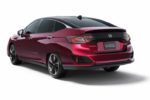Ever since its formation in 1946, Honda has been on the cutting edge of innovation and has continually displayed the ability to adapt to any situation that the constantly evolving marketplace presents. Most recently, an industry-wide revolution has spread far and wide. Because necessity is often what dictates invention, the need to reduce the emissions generated by internal combustion engines has led to more and more manufacturers and consumers alike turning their attention to hybrids and electric vehicles. Of course, Honda is no stranger to this, and you can find plenty of hybrid models at Honda dealers today.
The past few decades have seen a tireless effort on the part of Honda to make this technology more prevalent and available to a wider demographic of consumers. In the years to come, an even larger and more accessible hybrid and EV fleet will be found at Honda dealers across the country. We’re here to not only examine the present but to take a close look at the future and history of Honda’s hybrid and electric models. It’s time to climb into the way-back machine and begin…
1998-2000: Out With the Old, in With the New
Honda’s path to electric excellence doesn’t begin with a car fueled by electricity but rather one propelled by natural gas. The Honda Civic GX, which first made its debut in 1998, is to this day the only vehicle to run on compressed natural gas available to regular consumers. The car was in production until 2015 and earned rave reviews from industry critics as one of the “greenest” examples of a manufacturer offering an alternative to the gasoline-powered automobile.
While the introduction of the Honda Civic GX was a major breakthrough in what could be offered to consumers to lower emissions, it was an event that occurred the following year that set a new standard for the EV. While the Toyota Prius is unquestionably the most well-known hybrid vehicle on the market, it was beaten to the punch by the Honda Insight. Honda managed to deliver its first hybrid to the American market seven months before the Prius.
In an age where gas was still reasonably priced, the Insight proved to be absolutely astounding in terms of fuel consumption. The official numbers for the 2000 Insight were an amazing 49 MPG in the city and 61 MPG when on the highway. Running on a combination of a 1.0L three-cylinder engine and an electrical motor, this was the first step in a long journey that would show Honda’s ability to thrive in the new marketplace. While the Insight never received the reputation of the Prius, it paved the way for Honda’s expansion into hybrid technology and laid the groundwork for future models.
2003-2005: Fulfilling a Civic Duty
You don’t become the best by being complacent, especially when it comes to a marketplace that’s constantly growing by leaps and bounds. Naturally, Honda didn’t rest on its laurels and keep the Insight as its only contribution to the hybrid vehicle marketplace. Because the Honda Civic GX had brought the company several accolades, it only seemed natural to bring the new hybrid technology to the Civic as well. The result of this union was the 2003 Honda Civic Hybrid, and the fuel economy ratings that the vehicle generated were nothing short of impressive.
A 1.3L four-cylinder paired with a CVT and electric motors allowed the four-door sedan to achieve 40 MPG within the city limits. This number expanded to 43 MPG while on the highway, resulting in a combined 41 MPG. As complacency had always been the last thing on Honda’s mind, the Accord joined the ranks of its hybrid lineup in 2005. Despite the Accord being a midsize sedan that was larger than the Insight or Civic and equipped with a 3.0L six-cylinder engine, the Accord Hybrid put up some impressive numbers for its first year on the market. A combined 28 MPG was groundbreaking for a vehicle running on six cylinders and established Honda as an overpowering force in the continuing hybrid revolution.
2020: The SUV Goes Hybrid
Before Honda unveiled its first hybrid vehicle, it was already cornering the market on the SUV, courtesy of the CR-V. Debuting in 1997, the CR-V was a harbinger of what the SUV market would become in succeeding years. Smaller, with lower fuel consumption, and agile enough for any consumer to drive it around the city limits, the CR-V led the way for the current SUV craze. While the hybrid had been nearly synonymous with compact cars and sedans, 2020 was the year that Honda brought the same technology to one of its best-selling vehicles, the result being the CR-V Hybrid.
While AWD drivetrains are known for hindering fuel conservation in vehicles, that did absolutely nothing to stop the AWD CR-V Hybrid from being one of the most fuel-efficient SUVs on the market for 2020. A range of 532 miles on one tank of gas was just the tip of the iceberg, as it also achieved 40 MPG within city limits and 35 MPG while cruising on the highway. This meant the average fuel costs for an entire are less than the gas bill for your average sedan.
The Future…
Because the industry is at times impossible to predict, it’s hard to see what might occur with the current revolution of hybrids and electric vehicles. However, some manufacturers have already made their intentions quite clear, Honda among them. By the year 2030, Honda plans to roll out a large number of EVs, totaling upwards of thirty new vehicles, two of which will be geared for high performance. Honda’s joint effort with General Motors could possibly result in the largest influx of affordable EVs and one that rivals Volkswagen’s plans to have most of its fleet go electric over the course of the next decade.
One of the more interesting aspects on the horizon is that Honda is currently developing a plug-in hybrid version of the CR-V, which will give the manufacturer a chance to corner the marketplace with a new lineup of affordable electrified SUVs aimed directly at the average consumer. Some have been quite critical of the likelihood of Honda succeeding at the wildly ambitious venture, saying that the company has relied too heavily on the internal combustion engine and has fallen behind in terms of developing hybrid and electric models, especially when compared to manufacturers like Hyundai, Chevy, and Volkswagen. While the future is always unwritten, it’s no secret that history tends to repeat itself.
We draw attention to this because, in both the energy crisis of the 1970s and the humble beginnings of the EV movement, Honda has proven itself to be a company that can adapt to drastic and sudden changes in the marketplace. Whether it was the incredible fuel efficiency of the Insight, the unique propulsion engineering of the Civic GX, or even the adaptation of new technology for its current fleet of hybrid models, we can all rest assured that Honda will adapt. And perhaps in the process, Honda will even completely change the game in terms of what hybrid and electric vehicles can do. Despite the naysayers, there is a lot to look forward to from this dynamic company.




